- About us»
- Net income calculator»
- Population aging»
-
- Least developed regions»
-
- Average wage
- Material need benefits
- Meal allowance
- Counties of Slovakia
- Inflation
- Living and Subsistence Minimum
- Unemployment of Czechia and Slovakia
- NACE Classification
-
- Life expectancy
- Gender differences
- Youth unemployment and NEET
- Minimum wage in EU
- Unemployment rates of different age groups
- Share of salaries on GDP
- NEET
- Long term unemployment
- Unemployment rate
- Percentage of employees ususally working at nights
- Employment rate
-
- Bratislava and surroundings
- Kopanice
- Danube river
- lower Vah river
- middle Vár river
- upper Nitra river
- lower Nitra river
- Mining cities
- Kysuce a Orava
- upper Vah river - Liptov
- Spiš cities
- upper Hron river
- Juhoslovenská kotlina
- Košice fold and Torysa river
- upper Zemplín
- lower Zemplín
- EU regions
- NUTS3 regions of Slovakia
- LAU1 dataset
-
- Projects and activities
- Inclusive growth»
- Good work
- Project SKRS
- Social system – reality and vision
-
- Education of unemployed
- Young unemployed not taking part in education
- Proposal to change the system of education funding
- Library
- News»
- Contact
Spain – ES
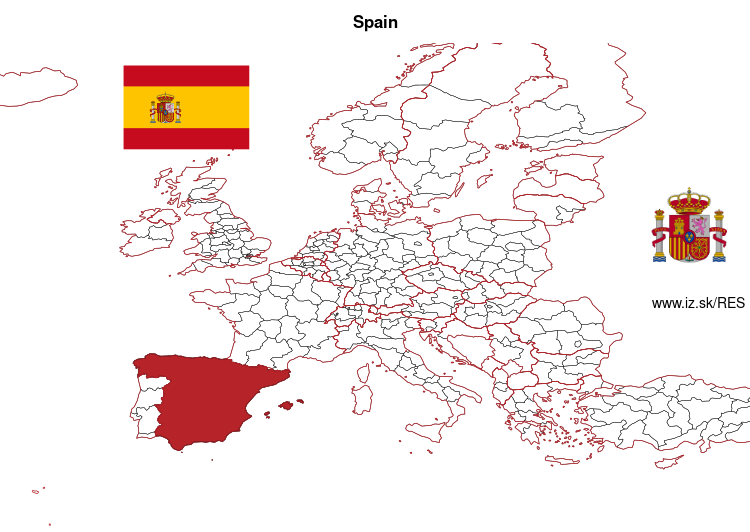
More on wikipedia wikidata Q29 on OpenStreetMap Spain slovensky: ES
Subregions: Noroeste, Noreste, Community of Madrid, Centro, Este, Sur, Canary Islands
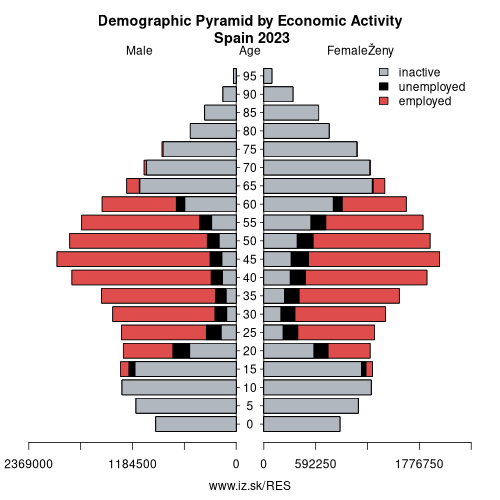
Unemployment
| Indicator | Period | Value |
|---|---|---|
| Unemployment | ||
| unemployment rate | 2025q3 | 10.6 |
| youth unemployment rate | 2025q3 | 25.4 |
| unemployment rate of low educated people | 2025q3 | 15.3 |
| Long term unemployment | ||
| long term unemployment | 2025q3 | 3.2 |
| share of long term unemployed | 2025q3 | 32.8 |
Composition of population according to age group, education and economic activity, Spain
| Age group | Low education | Middle education | High education |
|---|---|---|---|
| Y20-29 | P: 1136.1 E: 592.9; U: 251.5; I: 291.7 | P: 1890.8 E: 807.2; U: 222.5; I: 861.1 | P: 2096.8 E: 1485.7; U: 228.8; I: 382.3 |
| Y30-39 | P: 1809.9 E: 1234.1; U: 265.7; I: 310.1 | P: 1277.1 E: 999.8; U: 137.7; I: 139.6 | P: 2779.0 E: 2407.8; U: 192.2; I: 179.0 |
| Y40-49 | P: 2565.0 E: 1790.4; U: 310.6; I: 464.0 | P: 1762.1 E: 1413.1; U: 152.8; I: 196.2 | P: 3410.8 E: 3017.2; U: 183.6; I: 210.0 |
| Y50-59 | P: 3052.9 E: 1881.7; U: 344.8; I: 826.4 | P: 1761.3 E: 1283.2; U: 161.9; I: 316.2 | P: 2597.8 E: 2195.1; U: 130.4; I: 272.3 |
| Y60-69 | P: 3135.6 E: 734.8; U: 136.6; I: 2264.2 | P: 1211.9 E: 434.7; U: 44.7; I: 732.5 | P: 1569.2 E: 679.4; U: 45.6; I: 844.2 |
Note: in thousands in 2023, according to labour force sample survey. P – total population, E – employed, U – unemployed, I – number of economically inactive
Demographics
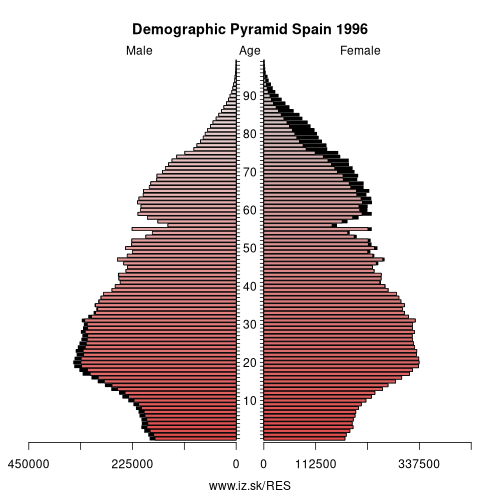
| Indicator | Period | Value |
|---|---|---|
| Demographics | ||
| number of inhabitants | 2024 | 48 619 696 |
| population density | 2023 | 96.2 |
| old-age dependency ratio | 2024 | 30.8 |
| Population ageing | ||
| unemployment rate – over 55 years | 2025q3 | 10 |
| aggregate replacement ratio | 2024 | 0.81 |
| aggregate replacement ratio – females | 2024 | 0.68 |
| life expectancy of a 50 year old | 2023 | 35.2 |
| healty life expectancy at 50 years | 2023 | 19.3 |
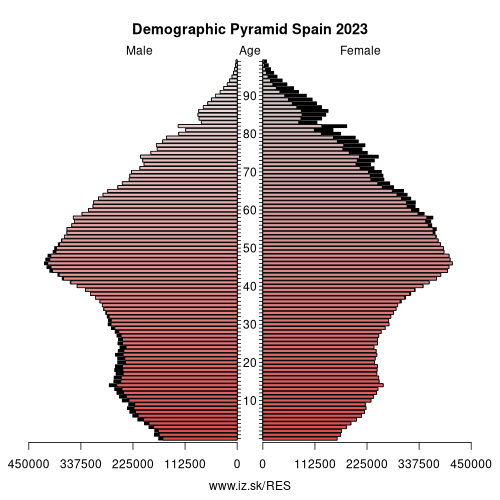
Employment by sectors, Spain
| NACE r2 | % | NACE r2 | % | ||
|---|---|---|---|---|---|
| A | 752.1 | 3% | B-E | 2886.8 | 13% |
| F | 1463.8 | 7% | G-I | 6187 | 29% |
| J | 831.7 | 4% | K | 450 | 2% |
| L | 164.4 | 1% | M_N | 2364 | 11% |
| O-Q | 5016.2 | 23% | R-U | 1537.9 | 7% |
| TOTAL | 21 654 | 100% |
Data for the period year 2024. Source of the data is Eurostat, table [lfst_r_lfe2en2].
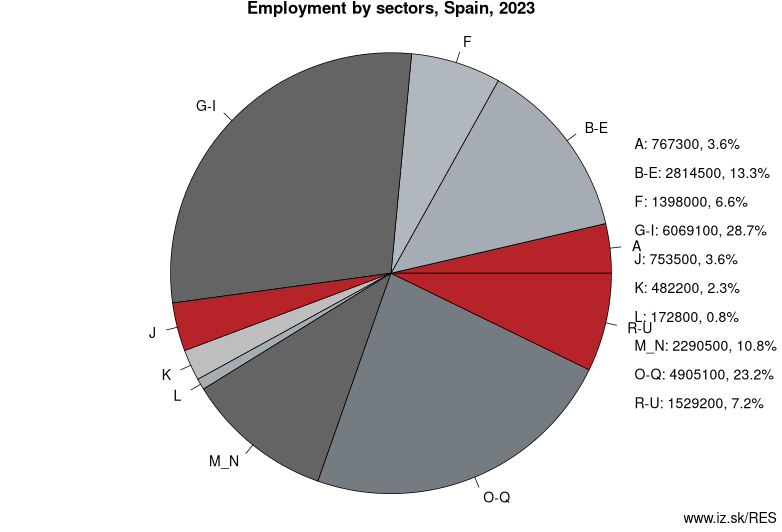
Spain (Spanish: España [esˈpaɲa] (listen)), officially the Kingdom of Spain (Spanish: Reino de España), is a country mostly located in Europe. Its continental European territory is situated on the Iberian Peninsula. Its territory also includes two archipelagoes: the Canary Islands off the coast of Africa, and the Balearic Islands in the Mediterranean Sea. The African enclaves of Ceuta, Melilla, and Peñón de Vélez de la Gomera make Spain the only European country to have a physical border with an African country (Morocco). Several small islands in the Alboran Sea are also part of Spanish territory. The country's mainland is bordered to the south and east by the Mediterranean Sea except for a small land boundary with Gibraltar; to the north and northeast by France, Andorra, and the Bay of Biscay; and to the west and northwest by Portugal and the Atlantic Ocean.
With an area of 505,990 km2 (195,360 sq mi), Spain is the largest country in Southern Europe, the second largest country in Western Europe and the European Union, and the fourth largest country in the European continent. By population (about 47 million), Spain is the sixth largest in Europe and the fifth in the European Union. Spain's capital and largest city is Madrid; other major urban areas include Barcelona, Valencia, Seville, Málaga and Bilbao.
Modern humans first arrived in the Iberian Peninsula around 35,000 years ago.
Other: Greece, European Union, Estonia, Spain
Subregions: Noroeste, Noreste, Community of Madrid, Centro, Este, Sur, Canary Islands
Suggested citation: Michal Páleník: Europe and its regions in numbers - Spain – ES, IZ Bratislava, retrieved from: https://www.iz.sk/PES, ISBN: 978-80-970204-9-1, DOI:10.5281/zenodo.10200164

 Share
Share Facebook
Facebook Twitter
Twitter News
News